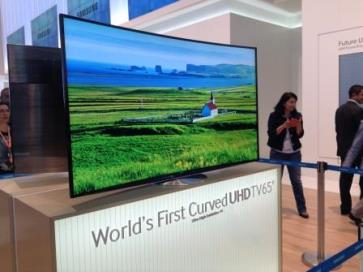|
Lately, I've been seeing a massive number of ads from Samsung about their curved flat-screen Ultra-HD TV. No doubt you've seen them endlessly, too. The ads are pretty clever, using a montage clips from movies to carrying on a dialogue about how wondrous and magical and perfect the new sets are, highlighted by Amy Adams saying "Show him the curve," from the aptly titled, Trouble with the Curve. While the line of dialogue might fit the ad spot-on, it's that movie title though which is more apt than the TV makers might wish. I say this having seen the curved flat-screen Ultra-HD TV sets, which I wrote about here a year ago at the IFA Berlin trade tech show. I haven't spent a great deal of time with the screens, but enough to formulate some ear The ads do make the technology seem wondrous. And in some ways some of it is. The problem is that there are two problems with it. The first is the curved screen itself. Part of the problem there is is that it's sort of gimmicky. A curved screen works well on a massive level in a movie theater, particularly the huge IMAX screens which are specifically trying to surround you in an immersive viewing experience. Home TV aren't trying to do that in the slightest. A curved home screen does create a slight sense of depth if you're sitting in the sweet spot -- but it can also create a distortion in parts, even if you are in the sweet spot, but most especially if you're not. And how often are you sitting in that "sweet spot," -- which might be a terrible location for the design of your room -- particularly if there's a roomful of people, who wouldn't have access to the "spot"? There's another problem, too, though, which can been gleaned very simply through nothing more than the product's very name -- "curved flat-screen Ultra-HD TV." The whole point (and much of the success) of flat-screen TVs is that they're...well, flat! Thin and flat and can be put in a corner or even hung on a wall and take up little space. Curving the screen and, in essence, increasing its space defeats the basic purpose of the flat screen TV. The second problem is bigger. Ultra High Definition TVs are indeed spectacular. Stunning resolution, otherwordly great. The problem is that there's no content for them. UHD technology isn't the same as when basic high-definition TVs came in. In that case, you simply plugged in the new TV, did some adjusting, and you got all of your programming. UHD, however, (also sometimes referred to as 4K) is a different standard completely, and it requires that the content sent to the TV be in a UHD/4K format that the television can read. Think of it this way. Imagine that once upon a time, someone gave you the worlds great DVD player. It was amazing and had all the bells-and-whistles that anyone could want. But at the same time...no one had invented a DVD disk yet. So, you'd have this spectacular player with absolutely nothing that can play on it. That's the problem right now with UHD. The content might be here one day, and even one day soon. But it isn't here now. And "soon" isn't on the immediate horizon. And for all we know, with how technology develops, some other standard may come along before 4K content can be developed. There are ways to get around this, devices that convert HD to to format that Ultra-HD can read. But even those aren't on the market yet. The 3D sets from Ultra-D (that's a product line name from the Stream TV company, different from the UHD protocol) which I've written about in the past can do that -- but even those aren't on the market yet. So, as much as the clip of Kevin Costner telling you that "It's perfect" -- it's better to keep in mind that other Kevin Costner movie they use a clip from, as well. Trouble with the Curve. It's a great technology. It just isn't, literally, ready for primetime yet.
0 Comments
Leave a Reply. |
AuthorRobert J. Elisberg is a political commentator, screenwriter, novelist, tech writer and also some other things that I just tend to keep forgetting. Feedspot Badge of Honor
Archives
June 2024
Categories
All
|
|
© Copyright Robert J. Elisberg 2024
|







 RSS Feed
RSS Feed